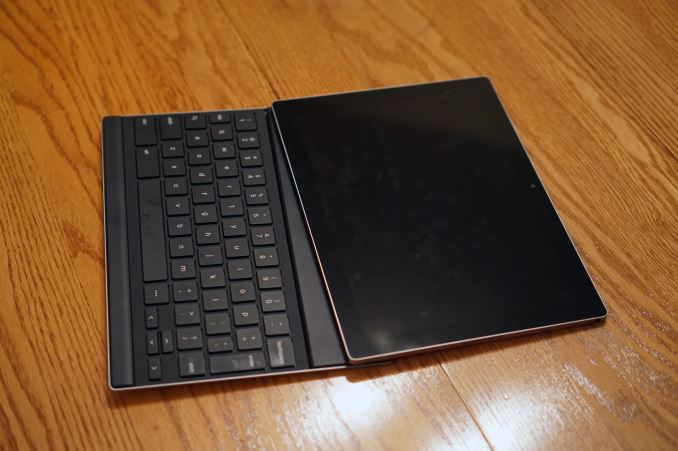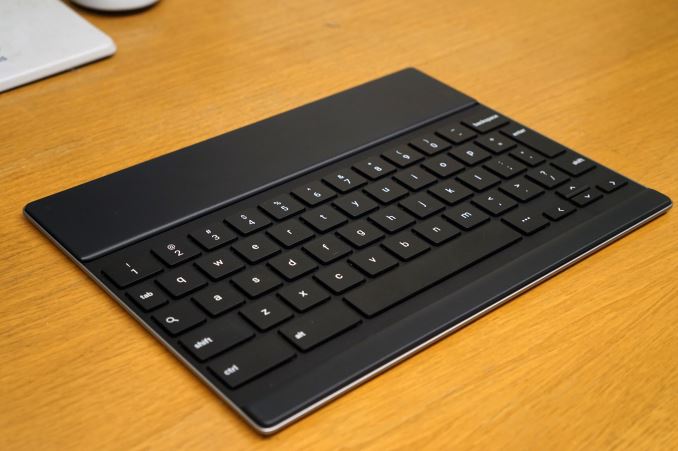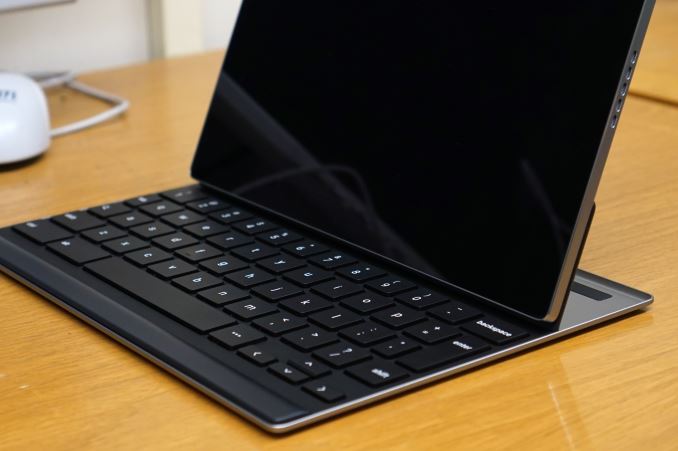The Google Pixel C Review
by Brandon Chester & Joshua Ho on January 25, 2016 8:00 AM ESTKeyboard
Part of the Pixel C’s appeal comes from the keyboard accessory. It isn’t included with the tablet itself, but this is true of most keyboards on tablets so it’s not as if the Pixel C is behind the competition in this regard. At $149 the keyboard is also well priced for one made out of machined aluminum, with full key travel and the Pixel C’s signature magnetic hinge.
Before talking about the keyboard itself, it’s probably a good idea to go over how that magnetic hinge works. The back of the Pixel C’s keyboard is a large aluminum flap with an equally large magnet on top. The best way you could describe the system is that this flap is connected to a very stiff hinge, which allows the flap to go to almost any angle up to about 85 degrees from the horizontal. The tablet has magnets embedded in its back which allow it to connect to this flap, and there’s enough strength in the connection to keep the tablet connected, as well as enough strength holding up the flap to prevent the mass of the tablet from causing it to start shifting back to a horizontal position. This system allows Google to give very fine angle adjustments without having to embed a kickstand in the Pixel C, and it’s quite a clever solution to the problem.
Of course, a unique keyboard solution does come with unique challenges. Obviously you end up with less space for the keyboard because the entire piece has to be the same size as the tablet, with a significant portion being dedicated to the magnetic flap. This is just an inherent result of the design, and while one could say it’s a waste, I would argue that the benefits of the system far outweigh this apparent downside.
The only real problem is training yourself to use the system correctly. When you put the tablet and keyboard together, you need to orient it with the tablet’s LED light bar on the same side as the keyboard’s space bar, or the keyboard won’t be able to charge using the Pixel C’s inductive charging. Unfortunately, this leads to some moments of confusion as you try to orient the tablet correctly after removing it. To split apart the keyboard and tablet Google recommends that you slide the two apart by pushing on the shorter sides of the keyboard and tablet. The first issue with this approach is that anything trapped between the keyboard and display is liable to absolutely ruin the glass, which has happened to my unit around some corners of the display.
The other issue is that once the two are separated you then need to remember to flip the tablet upward to put it in the right position to connect with the keyboard. While this seems like a natural motion, I find myself doing it incorrectly because even after sliding the two sections apart there’s still a magnetic attraction between the long edges of the tablet and keyboard, which causes me to favor rotating the tablet in order to separate them. In this case, the tablet ends up being upside down, and so you need to look at it and orient it such that the front-facing camera is on the top bezel before attaching it to the keyboard.
While some may feel that my issues working out the connection and disconnection of the keyboard are simply user error, it is worth noting that Google includes an enormous instruction sheet along with the Pixel C, and so confusion among users is clearly expected to some extent. I’ve gotten better at setting up the tablet in keyboard mode quickly, but it’s still not an action that has become a second nature to me.
Once you’ve set up the keyboard, you may notice something very familiar about it if you’ve had any experience with Google’s other Pixel products. The core part of the keyboard uses the exact same key size, pitch, and travel distance as the Chromebook Pixel. Google has shrunken the keys around the edges in order to match the keyboard to the Pixel C’s 10.2” display, but I haven’t found it to be much of a problem in use. On the contrary, I think the feel of the keyboard is great. The keys have a good tactile response, and the spacing is comfortable. In my eyes it definitely surpasses the iPad Pro’s Smart Keyboard by a large margin, although I’m not sure how well it compares to Microsoft’s Surface Type Cover.
Unfortunately, the keyboard becomes another area where the apparent mid-development switch to Android causes numerous issues. On the design side, you’ll notice that the keyboard follows the Chromebook Pixel in replacing the caps lock key with a search button. Right off the bat, I noticed a glaring issue with the implementation of this key. You can press search to open a search box anywhere, but I cannot find any way to close the search box if you open it by accident. If you open the search field you need to tap on the display to close it. There needs to be forgiveness in the design, either by making a backspace press when the field is empty close it, or by allowing you to close it by tapping search again with an empty field.
Android itself just doesn’t work very well with keyboards either. In fact, this implementation isn’t near as good as what I saw on the Dell Venue 10, and I didn’t think that provided a very good experience either. The big problem stems from the fact that Google hasn’t included proper navigation keys, which is more evidence that this device wasn’t ever meant to run Android in the first place. The omission of keys to trigger the standard home, back, and recent apps buttons is simply unacceptable. Google does have a help page online which lets you know the cryptic multiple key combos that perform these actions, but I don’t understand why a simple action like home needs to be activated by pressing search and enter, which are on entirely different sides of the keyboard. The same is true of back, which is search + backspace. Thankfully, Google does offer standard shortcuts in many of their apps, but the lack of navigational buttons on the keyboard is a big problem.
Ultimately, the Pixel C’s keyboard is a great piece of hardware, but Android doesn’t work very well with keyboards, and this keyboard in particular is ill suited to Android on top of that. Google has a very novel hinge implementation, and the inductive charging takes away the need to charge the keyboard, but many of the processes need to be streamlined and just generally made easier for the user to understand and get used to quickly. The tablet really needs to be able to attach onto and charge the keyboard without requiring a specific orientation, and the keyboard needs proper Android navigation shortcuts on top of Android simply needing much better keyboard support and applications to take advantage of one. I would love to see the ideas behind the Pixel C’s keyboard and hinge make it into keyboards from other manufacturers in the future, as well as future Android tablets that better deliver on promises of productivity abilities.














122 Comments
View All Comments
jbelkin - Monday, January 25, 2016 - link
Nailed it.McDuncun - Tuesday, January 26, 2016 - link
If you can show me one magnifying/proper visual difference between iOS 7-9 then I will buy myself a iPhone 6s Plus even though I still think it`s overrated beyond the point of no return.lightman0731 - Tuesday, January 26, 2016 - link
Actually, the third-world consumers that you say is not ignorant now. I come from China, in this market, opinion leader is indispensable, maybe consumers could not know how to choose SoC, but opinion leader is clearly know faster single core performance is key factor when we choose a smartphone or tablet, opinion leader usually care the single performance result from GeekBench or anything else. So if some company want to make a illusion that more cores are somehow better than faster individual cores, I believe it doesn't work in this information age.lilmoe - Wednesday, January 27, 2016 - link
just ignore that douchebag bro...GotThumbs - Wednesday, January 27, 2016 - link
"ignorant third-world consumers""mistaken belief that targeting the poorer class"
"market to the upper class."
WOW!
Talk about a person oozing ignorance.
We have a winner!
vFunct is THE king sphincter.
No facts, but lots of personal prejudice, bias and ignorance.
Alexey291 - Saturday, January 30, 2016 - link
Its really funny that he also thinks that google and apple actually operate in the same business too xDthegamper - Saturday, February 20, 2016 - link
I think it's just that ignorant third world customers are so stupid that they haven't yet grasped the joy of paying for apples huge profit margins, stock buybacks, shareholder dividends, etc so they can have the "look at me" product that makes them "feel" superior. Apple has done a truly magnificent job getting people to part with their money and feel good about getting gouged. Ever notice that nearly every protective case for Apple products has a cutaway to show the Apple logo. I think if you are honest with yourself, you know that's because if people can't see the logo, it might as well be a paperweight. So, you can pay through the nose for image, or you can pay a reasonable price for function. Maybe the 80% plus of the world running Android are more than ignorant peasants after all.randix - Friday, March 25, 2016 - link
LMAO. Having an iPad makes you so SUPERIOR. What kind of a loser would think like that? Upper Class?? The marketing of Apple makes those idiots like you to think it's cool to have an iDevice and you're poor if you choose other platforms and it seems to have worked for some iTards. I used to have a a few iPhones and iPads, I still have a Macbook. I guess I'm the Bill Gates now.Drout - Saturday, January 12, 2019 - link
?????? wow, this is a hell of a quirky comment, full of nonsense. I bet it was made by some spoiled kid between 13 and 15yo :)MonkeyPaw - Monday, January 25, 2016 - link
I concluded long ago that anything over 7" on Android will be frustrating thanks to the lack of App support. It's a pretty good phone OS, but it has never properly taken on in the tablet space.